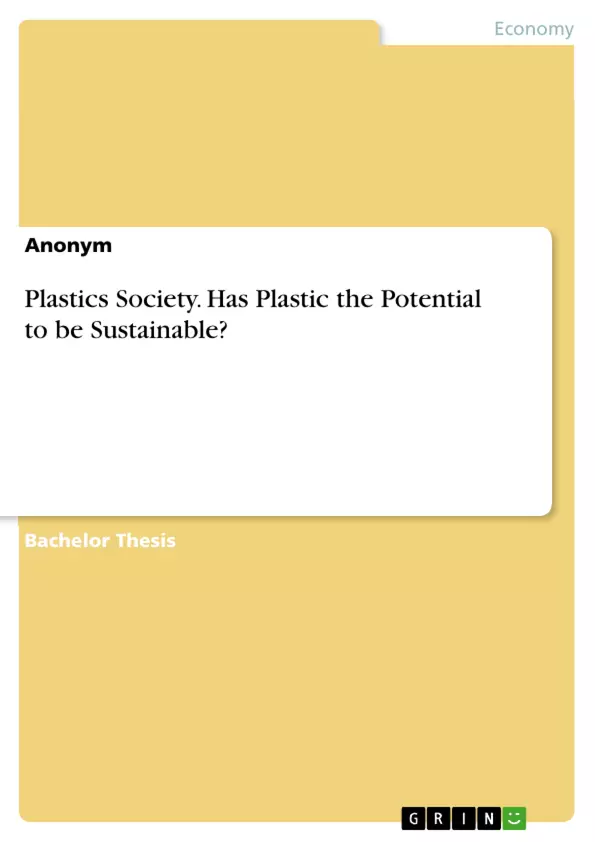This paper deals with the omnipresence of plastics as well as its popularity due to its diverse and advantageous properties, while it focuses especially on resulting environmental as well as human health consequences.
Therefore, the material plastic and its key features are introduced initially, with a special reference to plastic carrier bags that offer consumers primarily convenience. In addition, a general overview of the prospering plastic industry is given.
The paper aims to answer the question of whether the development of plastics can be described as sustainable at present – or whether it is supposed to become sustainable in the near future. Hence, the European waste hierarchy will be examined precisely, which reveals current processing of plastic waste. Afterwards, ecological and social externalities, as well as related market failures are outlined. While opting for solutions, variations of market instruments are applied to plastic carrier bags that serve as a potent example. In contrast to the classical theory that targets on the reduction of plastic waste itself, the Cradle-to-Cradle model takes a different approach. It promotes to rethink the design of plastic products in order to keep them in a continuous life cycle instead of focusing exclusively on the reduction of post-consumer plastic waste.
Inhaltsverzeichnis (Table of Contents)
- ABSTRACT
- List of Figure
- List of Abbreviations
- 1 Plastics Society - Introduction
- 1.1 Research Identification
- 1.2 Definition of Sustainability
- 2 Plastics Development
- 2.1 Plastic Facts
- 2.1.1 Bioplastic
- 2.2 Plastic Industry
- 2.2.1 Packaging Industry
- 2.2.2 Plastic Bags
- 2.3 Waste Hierarchy
- 2.4 Plastic Waste Markets
- 2.4.1 Plastic Waste Management in Germany
- 2.5 Marine Litter and Human Health Risks
- 2.6 Problem Definition and Market Failures
- 2.1 Plastic Facts
- 3 Solutions for a Sustainable Development
- 3.1 Viewpoints – Plastic Industry and European Union
- 3.2 Classical Theory - Market Instruments
- 3.3 Environmental Theory
- 3.3.1 Life Cycle Assessment
- 3.3.2 Cyclic-Economy
- 3.3.3 Cradle-to-Cradle
- 3.3.5 Practial Examples
- 4 Conclusion and Outlook
- LITERATURE
- APPENDIX
Zielsetzung und Themenschwerpunkte (Objectives and Key Themes)
This paper explores the widespread use of plastics and its environmental and human health consequences. It focuses on plastic carrier bags and aims to determine if the development of plastics can be considered sustainable. The paper examines the European waste hierarchy and analyzes ecological and social externalities, including market failures. It proposes solutions using market instruments and explores the Cradle-to-Cradle model as an alternative approach.
- The environmental impact of plastic production and consumption
- The sustainability of plastic development
- The role of market instruments in promoting sustainable plastic use
- The Cradle-to-Cradle model as a potential solution for plastic waste
- The European waste hierarchy and its effectiveness in managing plastic waste
Zusammenfassung der Kapitel (Chapter Summaries)
The first chapter introduces the research identification and defines sustainability. Chapter two focuses on plastics development, exploring plastic facts, including bioplastics, the plastic industry, packaging, and plastic bags. The chapter examines the waste hierarchy, plastic waste markets, particularly in Germany, and the human health risks associated with marine litter. Chapter three explores solutions for sustainable development, presenting viewpoints from the plastic industry and the European Union. It discusses classical market instruments and environmental theories like Life Cycle Assessment, cyclic-economy, and the Cradle-to-Cradle model, including practical examples.
Schlüsselwörter (Keywords)
The key themes and concepts explored in this paper include plastic waste, externalities, sustainable development, market instruments, and the Cradle-to-Cradle model. The paper also examines the European waste hierarchy and its role in managing plastic waste, as well as the challenges posed by market failures in addressing the issue.
- Citar trabajo
- Anonym (Autor), 2014, Plastics Society. Has Plastic the Potential to be Sustainable?, Múnich, GRIN Verlag, https://www.grin.com/document/909638



